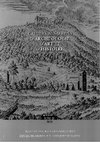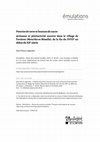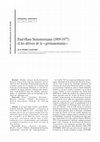Papers by Jean-Pierre Legendre
Villages Lorrains , 2025
In the late 1960s, the small village of Clémery, in the Lorraine region of France, was the scene ... more In the late 1960s, the small village of Clémery, in the Lorraine region of France, was the scene of unusual events. Pilgrims from all over France, as well as Belgium, Switzerland, Italy and Germany, gathered to attend masses celebrated by Michel Collin, a priest who had been dismissed from the clerical state and had proclaimed himself Pope under the name of Clement XV. A colorful character, Michel Collin should not be reduced to the role of a simple lunatic, as the press of the time often confined him. Beyond his outrageousness, he is a good example of the mystical excesses that can occur in Catholicism, but he also bears witness to the turbulence that shook the Church in the wake of the Second Vatican Council.
Journées Régionales de l'Archéologie Auvergne-Rhône-Alpes, 2023
An ongoing survey of archaeological excavations carried out between 1980 and 2012 in the Rhône-Al... more An ongoing survey of archaeological excavations carried out between 1980 and 2012 in the Rhône-Alpes region (France) has revealed a significant shortfall in publications. This phenomenon, which is affecting both research and preventive archaeology, is also perceptible at national and international level. Its causes are to be found in the dysfunction of the institutional system, rather than in a lack of resources or skills.
Des musées au-dessus de tout soupçon, 2007
Empreintes, Annuaire du Musée National d'Histoire et d'Art, 2008
Archaeology, Cultural Heritage and World War II. Italy, Greece, France and Finland as Historical Contexts, 2024
While in recent times a considerable amount of research has addressed World War I's
impact on Fr... more While in recent times a considerable amount of research has addressed World War I's
impact on France's archaeological heritage, the impact of the battles waged on
French soil during World War II has garnered only limited attention, and the few
studies that exist have essentially dealt with the damage done in urban contexts.
These observations prompt several questions: How did the destruction of
archaeological heritage wrought by the war occur, and where did it occur? What kinds
of archaeological sites were affected? Did the destruction had an impact on post-war
archaeological research? This essay attempts to offer a global assessment, and
focuses on both Allied bombings and the construction of the French (Maginot Line)
and German (Atlantic Wall) defensive positions.
Autopsie d'une tombe gauloise. La tombe à char de la Gorge-Meillet à Somme-Tourbe (Marne)
Graben für Germanien - Archäologie unterm Hakenkreuz, 2013

Cahiers Alsaciens d'Archéologie, d'Art et d'Histoire, 2009
In his 1989 book on Alsatian folk pottery, Georges Klein published a Julleuchter found in Oberna... more In his 1989 book on Alsatian folk pottery, Georges Klein published a Julleuchter found in Obernai ; he wrongly thought that it was made in Alsace in the 19th century. Fifteen years later, another study on Alsatian pottery by Bernard Demay once again presented this Julleuchter. It was attributed again to a workshop in Northern Alsace, along with a similar one discovered on an Alsatian antique market by "a well-informed collector". Both artifacts were wrongly dated again to the 19th century. It appears that the authors of these two studies were unaware of the sinister reality behind these objects. The Julleuchter was in fact one of the esoteric symbols of Nazi ideology, and was produced for the SS by deportees in the concentration camps of Dachau and Neuengamme. The presence of a SS Julleuchter in Obernai has to be linked to the fact that a SS school was established in this town in 1942. The second Julleuchter, found in Alsace by "a well-informed collector" is in fact one of the numerous fakes that are sold on the WW2 military collectibles market.
Atlas des sites archéologiques menacés - Patrimoine à protéger, 2023

Émulations - Revue de sciences sociales, 2023
The village of Favières shows an interesting variant of the proto-industrialization process and o... more The village of Favières shows an interesting variant of the proto-industrialization process and of its consequences. Located on poor agricultural land, it owed its development only to the growth of a craft industry turned towards export. In the 18th century, this was based on local resources (wood, stone, clay, hemp) and essentially supplied the surrounding countryside, sometimes quite far away. In the 19th century, new productions were introduced as part of the putting-out system. They went through contracts with urban entrepreneurs and were partly intended for a more urban clientele (embroidery, passementerie, mother-of-pearl buttons). This change was accompanied by a greater permeability between the worlds of agriculture and crafts, but also by mediocre salaries which penalised women in particular. This situation accelerated the departure of young adults to the industrial area of Nancy and led to a demographic decline.

Antiquités Nationales, 2011
Membre éminent du Reichsbund für Deutsche Vorgeschichte dont une délégation visite le Musée de An... more Membre éminent du Reichsbund für Deutsche Vorgeschichte dont une délégation visite le Musée de Antiquités Nationales en 1937, Paul-Hans Stemmermann peut être considéré comme un cas typique de la manière dont beaucoup d'archéologues allemands se sont fait les complices du régime hitlérien, oubliant toute déontologie, sombrant parfois dans une véritable «germanomanie » et contribuant à faire de l'archéologie un des piliers de l'idéologie nazie.
Abstract: As an major figure member of the Reichs-bund für Deutsche Vorgeschichte – a delegation of which visited the Musée des Antiquités Nationales in 1937 –, Paul-Hans Stemmermann may be seen as a typical example of the way followed by many German archaeologists who became the accomplices of the Hitlerian regime, throwing away their consciousness and, for some of them, sinking into a true «Germanomania » and contributing to establish archaeology as one of the very basis of Nazi ideology.
Les Cahiers Lorrains, 2008
Archaeologia Mosellana, 2012
Archaeologia Mosellana, 2014
Le rôle joué par l'armée romaine sur le territoire de la Lorraine actuelle a été longtemps sous-e... more Le rôle joué par l'armée romaine sur le territoire de la Lorraine actuelle a été longtemps sous-estimé. De nombreuses sources historiques, épigraphiques et surtout archéologiques témoignent pourtant de la présence des légions et de leurs auxiliaires depuis la guerre des Gaules jusque dans la première moitié du Ve siècle ap. J.-C.
Die Rolle, die der römischen Armee auf dem Territorium des heutigen Lothringen spielte war lange Zeit unterschätzt, obwohl viele historische, epigraphische und archäologische Quellen die Präsenz der Legionen und ihre Hilfstruppen seit dem Gallischen Krieg bis in der ersten Hälfte des fünften Jahrhunderts nach Christus bezeugen.
Les ponts routiers en Gaule romaine, 2011

L' Austrasie: sociétés, économies, territoire, christianisation, 2008
Jenecroispasquelerespectdûaux jeunes impliquequel'on fassesilencesur leserreurs de notregénératio... more Jenecroispasquelerespectdûaux jeunes impliquequel'on fassesilencesur leserreurs de notregénération. » Primo Levi(1919-1987 1 L eregardportéparleshistoriensetlesarchéologuessur le peuplementde laG aule suiteaux «GrandesInvasions»afortementévoluél ors de cesdernièresdécennies.Del 'image initiale d'une véritable déferlanted etribus germaniquesquiavaitencorecours aumilieuduXX e siècle, on s'est progressivementorientévers despositionsbeaucoup plus nuancéesoùlaquestion ethniquen 'est qu'unaspect parmi d'autresetoùlesphénomèness ociaux,politiques, culturelsetéconomiquess ontdésormaislargementprisen compte 2 .Enceq uiconcerne laL orraine,laquestion est comme on peut le devinerunsujetparticulièrementsensible, dansune région quifut siâprementdisputée entrelaFranceet l'Allemagne. Iln ef aut certespass 'étonnerquel esautorités naziesaient,entre1940et1944,largementutilisécetépisode historiquep our tenterde légitimerl'annexion forcée du départementde laMoselle 3 .Ceseraitcependantune erreur de croireq uecettetendanced ériveuniquementde lapolitique expansionnistedurégime hitlérien,carelle trouvesesracines dansplusieurs courants d'idéess ouventbien antérieurs àc e dernier:le mouvement völkisch ,le pangermanisme etla Westforschung.Pratiquementinconnus de nosjours en France,ils ontpourtantinfluencédurablementlesscienceshumainesen Allemagne,notammenten cequiconcerne lestravaux historiquesetarchéologiques.La chutedunazisme n'apassignifié celle de cesidéologies,dontlestracessontencoreprésentesde manièrediscrètedanslarecherche actuelle,même siceux qui manientcertainsdesconcepts quiensontdérivésne sontsans doutepastoujours conscients de leur origine réelle.
Renaissance du Vieux Metz et des Pays Lorrains, 2023










Uploads
Papers by Jean-Pierre Legendre
impact on France's archaeological heritage, the impact of the battles waged on
French soil during World War II has garnered only limited attention, and the few
studies that exist have essentially dealt with the damage done in urban contexts.
These observations prompt several questions: How did the destruction of
archaeological heritage wrought by the war occur, and where did it occur? What kinds
of archaeological sites were affected? Did the destruction had an impact on post-war
archaeological research? This essay attempts to offer a global assessment, and
focuses on both Allied bombings and the construction of the French (Maginot Line)
and German (Atlantic Wall) defensive positions.
Abstract: As an major figure member of the Reichs-bund für Deutsche Vorgeschichte – a delegation of which visited the Musée des Antiquités Nationales in 1937 –, Paul-Hans Stemmermann may be seen as a typical example of the way followed by many German archaeologists who became the accomplices of the Hitlerian regime, throwing away their consciousness and, for some of them, sinking into a true «Germanomania » and contributing to establish archaeology as one of the very basis of Nazi ideology.
Die Rolle, die der römischen Armee auf dem Territorium des heutigen Lothringen spielte war lange Zeit unterschätzt, obwohl viele historische, epigraphische und archäologische Quellen die Präsenz der Legionen und ihre Hilfstruppen seit dem Gallischen Krieg bis in der ersten Hälfte des fünften Jahrhunderts nach Christus bezeugen.
impact on France's archaeological heritage, the impact of the battles waged on
French soil during World War II has garnered only limited attention, and the few
studies that exist have essentially dealt with the damage done in urban contexts.
These observations prompt several questions: How did the destruction of
archaeological heritage wrought by the war occur, and where did it occur? What kinds
of archaeological sites were affected? Did the destruction had an impact on post-war
archaeological research? This essay attempts to offer a global assessment, and
focuses on both Allied bombings and the construction of the French (Maginot Line)
and German (Atlantic Wall) defensive positions.
Abstract: As an major figure member of the Reichs-bund für Deutsche Vorgeschichte – a delegation of which visited the Musée des Antiquités Nationales in 1937 –, Paul-Hans Stemmermann may be seen as a typical example of the way followed by many German archaeologists who became the accomplices of the Hitlerian regime, throwing away their consciousness and, for some of them, sinking into a true «Germanomania » and contributing to establish archaeology as one of the very basis of Nazi ideology.
Die Rolle, die der römischen Armee auf dem Territorium des heutigen Lothringen spielte war lange Zeit unterschätzt, obwohl viele historische, epigraphische und archäologische Quellen die Präsenz der Legionen und ihre Hilfstruppen seit dem Gallischen Krieg bis in der ersten Hälfte des fünften Jahrhunderts nach Christus bezeugen.
sites or ones that are even more recent. The barriers that once compartmentalised the fields of history, archaeology and anthropology have begun to crumble, yielding a vast common space, that of the present. The resulting challenges to traditional methodologies have generated a silent revolution that is undermining the ways these disciplines dealt with the past. Will we prove capable of acknowledging this new state of the social sciences and act accordingly?